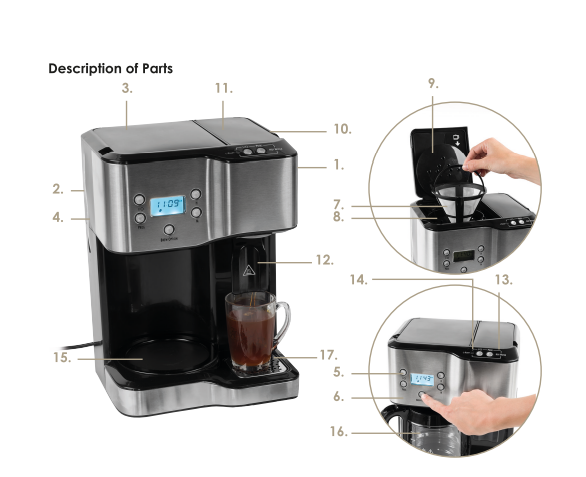As an Amazon Associate, I earn from qualifying purchases.
Unlock the mystery behind what “prog” means on a coffee maker. Discover its significance, functions, and how it enhances your coffee brewing experience.
Introduction
Prog Mean on a Coffee Maker: Coffee makers have evolved significantly over the years, offering various features to cater to different preferences and lifestyles. Among these features, you may have encountered the term “program” on your coffee maker’s control panel. But what exactly does “Prog” mean, and how can it enhance your coffee brewing experience? Let’s delve into this intriguing aspect of coffee maker functionality.
Understanding Coffee Maker Terminology
Before we explore the meaning of “Prog,” it’s essential to grasp the diverse features that modern coffee makers offer. From programmable timers to adjustable brew strengths, coffee makers have functionalities designed to streamline the brewing process and enhance user convenience.
Different Features of Coffee Makers
Coffee makers may include features such as:
- Programmable timers
- Brew strength settings
- Auto-shutoff
- Temperature control
- Brew size options
Programming Feature Overview
One of the standout features of many coffee makers is the ability to program them according to your schedule and preferences. This feature allows users to set the coffee maker to start brewing at a specific time, ensuring a fresh pot of coffee is ready when needed.
What Does “Prog” Mean?
“Prog” is a shortened form of “Program” and typically refers to the programming functionality available on certain coffee makers. This feature allows users to set the coffee maker to start brewing automatically at a predetermined time.
Defining “Prog”
In the context of a coffee maker, “Prog” enables users to pre-set the brewing time, ensuring that they wake up to the aroma of freshly brewed coffee or return home to a hot pot after a long day.
Purpose and Functionality
The primary purpose of the “Prog” function is to offer convenience and customization to coffee enthusiasts. By programming the coffee maker, users can eliminate the need to manually start brewing every time they desire a cup of coffee. Additionally, it allows for flexibility in managing brewing times according to individual schedules.
How to Use the “Prog” Function
Utilizing the “Prog” function on your coffee maker is relatively straightforward. Follow these step-by-step instructions to set it up:
Access the Programming Menu: Depending on your coffee maker model, locate the programming menu on the control panel.
Set the Brew Time: Use the buttons or dials to adjust the desired brew time, taking into account factors such as wake-up time or anticipated coffee breaks.
Confirm Settings: Once you’ve inputted the desired brewing time, confirm the settings to activate the programming function.
Enjoy Freshly Brewed Coffee: Sit back and relax as your coffee maker automatically starts brewing at the specified time, ensuring a hassle-free coffee experience.
Benefits of Using the “Prog” Feature
Incorporating the “Prog” feature into your coffee brewing routine offers several advantages:
Convenience
Setting the coffee maker to start brewing at a predetermined time eliminates the need for manual intervention, saving time and effort, especially during busy mornings or hectic schedules.
Customization
With the ability to program brewing times, users can tailor their coffee consumption to align with their daily routines, ensuring a consistent supply of freshly brewed coffee whenever desired.
Common Issues and Solutions
While the “Prog” function enhances user convenience, occasional issues may arise. Here are some common problems and their solutions:
Power Interruptions: In the event of a power outage, ensure that your coffee maker is equipped with a backup battery or reset the programming after power restoration.
Maintenance Issues: Regularly clean and descale your coffee maker to prevent malfunctions that may affect the programming functionality.
Maintenance Tips for “Prog” Function
To ensure optimal performance and longevity of the “Prog” function on your coffee maker, consider the following maintenance tips:
- Clean the coffee maker regularly, including the programming interface, to prevent debris buildup that may interfere with functionality.
- Check the user manual for specific maintenance instructions recommended by the manufacturer.
- Conduct periodic inspections to ensure all components are functioning correctly and address any issues promptly.
Conclusion
In conclusion, the “Prog” function on a coffee maker offers a convenient and customizable brewing experience for coffee enthusiasts. By understanding its functionality and implementing proper usage and maintenance practices, users can enjoy consistently fresh and flavorful coffee tailored to their preferences and schedules.
FAQs on Prog Mean on a Coffee Maker
Can I use the “Prog” function to brew different types of coffee?
Yes, you can program the coffee maker to brew various types of coffee by adjusting the settings accordingly.
Does the “Prog” function work with all coffee maker models?
Not all coffee makers feature the “Prog” function. Refer to the user manual or product specifications to determine if your coffee maker includes this capability.
Can I program multiple brewing times with the “Prog” function?
Some advanced coffee makers may allow for multiple programming options, enabling users to set different brewing times throughout the day.
What should I do if the “Prog” function stops working?
If you encounter issues with the “Prog” function, refer to the troubleshooting section of your coffee maker’s user manual for guidance on resolving common problems.
Is it safe to leave the coffee maker programmed overnight?
As long as the coffee maker is in good working condition and properly maintained, programming it to brew overnight should not pose any safety risks.
As an Amazon Associate, I earn from qualifying purchases.







